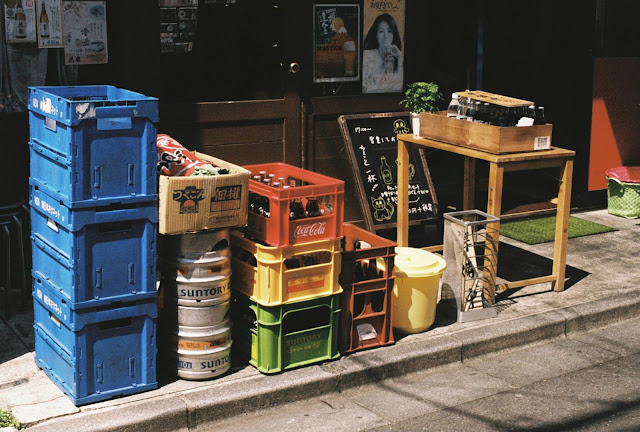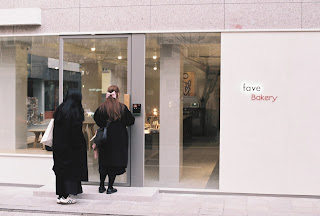Rather than try to make a cohesive story out of my week in Japan, the next two(?) blogs are going to be broken up into smaller pieces. I’m going to devote a section to each of the areas of the city I liked most.
Akihabara:
If you were to conjure up an image of
Tokyo in your head, you’d be envisaging Akihabara’s Electric Town. The gigantic
towers of neon play host to Japan’s largest arcades and smallest boutique anime
shops. You’ll find the capsule-toy dispensing vending machines known as gachapons lining the streets and images
of scantily clad anime characters covering the walls and a dizzying number of
tiny eight-seat eateries and electronics markets of impossible variety and a
slew of women dressed as servants ushering you into the closest maid café and
endless arcades blasting what I could only describe as “noise” at
ear-shattering volumes. It’s overwhelming, to say the least.
 |
| An arcade in Akihabara |
Akihabara is the mecca of one corner of
Japanese culture. It’s the result of combining every fringe aspect of society
in a pot, adding a good helping of pachinko machines, turning the burner to
eleven, and then letting the pot overflow. I was no more than a bewildered
onlooker, but I want to stress that Electric Town does not define the whole of
Tokyo. The city of 13 million is diverse beyond belief, and to consider
Akihabara as the capital of culture would be a great disservice.
Yasukuni Shrine:
Ever wanted to support a far-right
Japanese political party that does not acknowledge WWII war crimes? Well come
on down to Yasukuni Shrine and museum, located just northeast of Ichigaya
station! Yasukuni was constructed during the Meiji restoration of the mid-19th
century to commemorate the lives of fallen soldiers, but after World War Two,
the shrine fell into controversy after the Shinto priests interned convicted
war criminals. Since then, the site has become a point of contention for the
Korean and Chinese governments. They claim that the shrine defends the Japanese
militaristic aggression and colonization of the 20th century.
Regardless, the gorgeous building and gardens draw thousands of tourists and
locals every day.
While I obviously don’t want to make
oversimplified statements about a political situation I have limited
familiarity with, the museum at Yasukuni presents the most biased, dangerous,
and above all, shocking account of the second world war I have ever seen. Before
I go any further, though, I want to make it clear that what I saw in the museum
is not a reflection of the Japanese population at large, only the ideas of a
small, radical, and nationalistic subset.
A plaque outside the museum described
the peculiar sentiment that is echoed inside. It’s dedicated to the Justice who
defended the Japanese war criminals after the war. The Indian judge has gained
a certain celebrity in Japan for his unwavering commitment to “justice”. The
inside is just as astonishing as the exterior. What starts as a jaunt through
old samurai armor and historical weapons quickly turns into a revisionist
nightmare. The exhibits paint Japanese hostility as a necessary inevitability,
where the massacre of the Chinese city Nanjing is disregarded simply as the
“China incident” and the bombing of pearl harbor is described as a victim’s
retaliation. The tour is also filled with letters from kamikaze pilots and
widowed mothers exalting the patriotic bravery of soldiers.
 |
| Yasukuni Gardens |
Odaiba:
Without a doubt, visiting an onsen was the best part of my trip. For
those of you who are unaware, onsen are
traditional hot spring baths that serve as the Japanese equivalent of a spa. The
particular onsen I chose, however,
was some amalgam of spa, theme park, restaurant, and tea house. As you would
imagine, it was a fantasy-land of Japanese culture specifically designed for my
enjoyment (well, at least for the enjoyment of people like me).
 |
| Some festival prizes |
 |
| The Tea Room |
I walked into the massive complex that
is Odaiba Onsen around 9:30 on a Wednesday morning –not the most happening time
at the bathhouse. Naturally, everyone is required to take off their shoes first
thing. So before even being able to speak with an employee, I put my sneakers
in a locker and grabbed the key which was wrapped around one of those coiled
shoelace bracelets. Key #1. From there, I was directly given a second locker
key with an attached plastic barcode and a yukata,
a light, cotton kimono worn at onsen.
Key #2.
Men and women split ways after the
lobby, so I headed on into the men’s room to change. I was a bit nervous at
this point that the onsen would disappoint.
The main entrance looked like a defunct hotel from the 1990’s and the changing
room could have been plucked from any Texas high school’s football locker-room.
However, I had just been given a badass, Samurai-Champloo-esk outfit, so I stashed
all my stuff, fumbled around with my yukata
for 20 minutes not knowing how to tie it, and stepped into the onsen proper.
Whether
it was a gimmick or not, the ancient festival scenery blew me away. The
building was designed to mimic a lantern-lit carnival in the Edo period of
Japan. Games, food stands, performances, and peddlers lined the “streets” in an
odd hodgepodge of artificiality and authenticity. Here, families, couples, and
lonely white tourists could eat, drink, and take in the sights. In the center
stood a lantern-draped tower and a performance stage crowded with cardboard
anime figures. The juxtaposition was off-putting but also charming: only in
Japan could anime posters be situated in front an historical backdrop feel
appropriate.
Through another set of locker-rooms stood the actual, sex-divided hot springs. I was given two towels and another locker for my yukata before heading in. Key #3. Like most traditional saunas or hot springs, onsen typically don’t allow clothing in the baths, so I ditched my skivvies before following a group of elderly gentlemen inside. The springs, again, surprised me. Walking in, on the left were 30 or so seated shower stations where guests first wash up. Around the room were eight or so large, jacuzzi type baths of varying temperature. Along the far wall were private massage rooms (at an extra cost) and a sauna. There was also an outdoor area with an additional set of sun-drenched baths. I was especially partial to the Micro Nano Bath, whatever that is supposed to mean.
Besides the baths, I spent the rest of my Treat-Yo-Self morning eating Katsudon, drinking tea, playing festival games, and generally grinning like an idiot. It was great: a mini vacation in the middle of my vacation. However, at around 1:00 in the afternoon, I had to hang up my hat – in this case return the assortment of key-bracelets I’d been given – and convince myself to leave.
 |
| The Onsen Tower, sorry it's so dark |
Through another set of locker-rooms stood the actual, sex-divided hot springs. I was given two towels and another locker for my yukata before heading in. Key #3. Like most traditional saunas or hot springs, onsen typically don’t allow clothing in the baths, so I ditched my skivvies before following a group of elderly gentlemen inside. The springs, again, surprised me. Walking in, on the left were 30 or so seated shower stations where guests first wash up. Around the room were eight or so large, jacuzzi type baths of varying temperature. Along the far wall were private massage rooms (at an extra cost) and a sauna. There was also an outdoor area with an additional set of sun-drenched baths. I was especially partial to the Micro Nano Bath, whatever that is supposed to mean.
Besides the baths, I spent the rest of my Treat-Yo-Self morning eating Katsudon, drinking tea, playing festival games, and generally grinning like an idiot. It was great: a mini vacation in the middle of my vacation. However, at around 1:00 in the afternoon, I had to hang up my hat – in this case return the assortment of key-bracelets I’d been given – and convince myself to leave.
More to follow in part 3
-JCP














